Este post também está disponível em:
Português
English
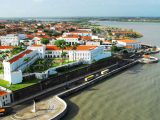
São Luís or São Luís do Maranhão is a Brazilian municipality and the capital of the state of Maranhão.
With more than four centuries of history, the city gathers attractions portrayed as Cultural Heritage of Humanity, in addition to the largest architectural ensemble of Portuguese tiles in Latin America.
The Historic Centre of São Luís do Maranhão has about 4,000 buildings from the 18th and 19th centuries.
Among the most emblematic are the Palácio dos Leões, the Catedral da Sé, the Convento das Mercês, the Casa das Minas and the Artur Azevedo Theatre.
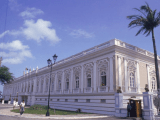
The mixture of peoples generated a rich set of cultural manifestations, such as bumba-meu-boi, tambor de crioula, cacuriá and the traditional June festivals.
In addition, the city has a strong influence of Jamaican music and is popularly called the Brazilian capital of reggae.
Another strong point is the cuisine, which offers dishes such as cuxá rice, fried fish and prawn pie.
Açaí, tapioca and bacuri ice creams are also among the local favourites.
São Luís do Maranhão is the only Brazilian city founded by the French on 8 September 1612, was invaded by the Dutch and finally colonised by the Portuguese.
It is located on the island of Upaon-Açu in the South Atlantic, between the bays of São Marcos and São José de Ribamar.
In 1621 when Brazil was divided into two administrative units – the State of Maranhão and the State of Brazil – São Luís was the capital of the first administrative unit.
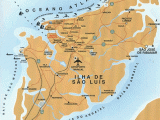
In 1997, the city’s historic centre was declared a World Heritage Site by UNESCO;
Video
History of the Founding of São Luís MA

History of the Foundation of São Luís do Maranhão
For many years, the north of Brazil was ignored by the Portuguese Crown.
São Luís then became a haven for pirates and became coveted by the French, who were already interested in establishing a colony in these lands.
On 19 March 1612, an expedition left the port of Cancale, France, to cross the Atlantic and reach the Bay of Saint Mark, with the prospect of conquering the Gulf of Maranhão and establishing Equinoctial France.
In command was Daniel de La Touche, lord of La Ravardière, associated with François de Razilly, lord of Razilly, Aunelles – aide-de-camp to King Henry IV, a gentleman of his chamber, related to Cardinal Richelieu – Nicolas de Harlay, lord of Sancy, and the Baron de Molle and Gros-Bois, a member of Parliament and the King’s Council.
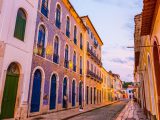
With them, a caravan of 500 men arrived in the new land on three large ships. For them, the place was strategic for maritime trade.
“There is nothing there comparable to the beauty and delights of this land, as well as the fruitfulness and abundance in everything that man can imagine”.
These are the words of the Capuchin friar Claude d’Abbeville in “História da missão dos padres capuchinhos na Ilha do Maranhão e terras circunvizinhas”, published in 1614 and translated by Sérgio Milliet, in which he gives a relevant description of the foundation of the city, where he was present.

Arrival of the French
The French arrived on the island of Upaon-Açu (Ilha Grande), so named by the Indians who inhabited it, on 12 August 1612.
Ignoring the Indians who already inhabited the region, it was agreed that the foundation took place on 8 September of that year, a date consecrated to the Most Holy and Immaculate Virgin Mary.
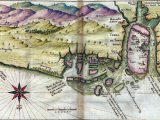
The landmark of this moment was the installation of a large cross, followed by mass and procession.
The Catholic symbol was erected in front of the fortification on the outskirts where the city was to expand.
The fort in question is Saint-Louis, in honour of the boy king Louis XIII.
The name would eventually be extended to the town and the whole island. “When the cross was erected […] the island was also blessed, while from the forts and ships many cannon shells were fired in a sign of rejoicing,” Claude d’Abbeville recounts.
One of the aims of the venture was to establish a Catholic colony in South America.
For the Church, the discovery of the new world entailed the need to catechise the Indians.
The historical information contained in Claude d’Abbeville’s book states that the Tupinambás were interested in the newly introduced religion.
Portuguese Resumption
In 1614, a Portuguese military expedition, which history has named the Miraculous Journey, expelled the French from Maranhão.

The commander Jerônimo de Albuquerque settled at the mouth of the Munim, where he built the fort of Santa Maria, on the site of Guaxenduba.
Daniel de La Touche, lord of La Ravardière, attacked the fort on 19 November, but was defeated in the battle.
The Battle of Guaxenduba was an important step taken by the Portuguese towards the definitive expulsion of the French from Maranhão. In the 1759 book História da Companhia de Jesus na Extinta Província do Maranhão e Pará, Father José de Moraes reports the appearance of Our Lady of Victory to intervene on the Portuguese side.
The saint allegedly turned sand into gunpowder and pebbles into projectiles.
Dutch presence
In 1641, a Dutch squadron, under the orders of Admiral Jean Cornelizoon Lichardt, bringing 2,000 men-at-arms, sacked the town, taking Governor Bento Maciel prisoner.
The Dutch intended to expand the sugar industry by obtaining new areas of sugar cane production in the interior of the captaincy, as they had already done in other cities in the Northeast.
The Dutch were expelled from São Luís by the Portuguese in 1644.
The settlers were led by Antônio Teixeira de Melo, who had succeeded Antônio Muniz Barreiros as leader of the resistance to the invaders.
To prevent further invasions, the government of the colony decided to found the state of Grão-Pará and Maranhão, independent from the rest of the country, ensuring colonisation.
After the expulsion of the French, the fort of Saint-Louis was renamed São Phelippe, in honour of the reigning monarch of Portugal.
The settlement, however, remained called São Luís.
History of the Foundation of São Luís do Maranhão
Tourism and Travel Guide of São Luís do Maranhão




















